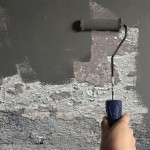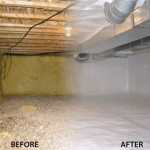Ideas for Finishing Concrete Basement Stairs
Concrete basement stairs, while structurally sound and durable, often present an unfinished and utilitarian aesthetic. Transforming these stairs into an attractive and functional element of the home requires careful planning and execution. There are numerous approaches to finishing concrete basement stairs, ranging from simple cosmetic enhancements to comprehensive renovations. The optimal choice depends on factors such as budget, desired aesthetic, ease of installation, and the overall style of the home. This article explores several viable options for finishing concrete basement stairs, providing insights into their advantages, disadvantages, and installation considerations.
Preparation is Key
Regardless of the chosen finishing method, proper preparation of the concrete surface is crucial for a successful and long-lasting result. This typically involves a thorough cleaning to remove dirt, dust, debris, and any existing coatings or adhesives. Degreasers may be necessary to eliminate oil stains, while pressure washing can be effective for removing loose particles. Cracks and imperfections in the concrete should be repaired with a concrete patching compound, ensuring a smooth and even surface. Once the patching compound has cured, it should be sanded flush with the surrounding concrete. In some cases, grinding the concrete surface may be necessary to create a better bonding surface for subsequent finishes. This is particularly important when applying thin coatings or adhesives. Before proceeding with any finishing work, the concrete must be completely dry.
Addressing moisture issues proactively is also vital. Basement environments are often prone to dampness, which can compromise the integrity of any applied finish. Verify that the basement has adequate ventilation and consider installing a dehumidifier to control humidity levels. If there are signs of water intrusion, such as efflorescence (white, powdery deposits on the concrete surface) or damp spots, identify and address the source of the moisture before commencing any finishing work. Applying a waterproof sealant to the concrete surface can help prevent moisture from migrating through the material and damaging the finish. This is especially important if applying carpet or wood treads directly to the concrete.
Painting Concrete Stairs
Painting is one of the most cost-effective and straightforward methods for finishing concrete basement stairs. It offers a wide range of color options and can significantly improve the aesthetic appeal of the stairs. However, it is important to select a paint specifically formulated for concrete surfaces. These paints are typically more durable and resistant to moisture and abrasion than standard interior paints. Epoxy-based paints are a good option for concrete stairs, as they provide a hard, durable finish that can withstand heavy foot traffic. Alternatively, concrete stains provide a more subtle color enhancement while allowing the natural texture of the concrete to remain visible. Concrete stains penetrate the surface rather than forming a film, making them less prone to chipping or peeling.
The application process for painting concrete stairs typically involves several steps. First, the concrete surface should be thoroughly cleaned and prepared as described above. A concrete primer should be applied to improve adhesion and ensure a uniform finish. Once the primer has dried, apply two coats of the chosen concrete paint, allowing each coat to dry completely before applying the next. For stairs that will experience heavy foot traffic, consider applying a clear polyurethane sealant over the painted surface to provide added protection and durability. While painting is a relatively simple and inexpensive option, it does require regular maintenance to prevent chipping and fading. The stairs may need to be repainted every few years, depending on the level of traffic and wear.
Safety considerations are paramount when painting concrete stairs. Use a paint with a non-slip additive or apply a non-slip coating after painting to prevent falls. Ensure adequate ventilation during the painting process to avoid inhaling harmful fumes. Wear appropriate protective gear, such as gloves and a respirator, to minimize exposure to chemicals. Also, consider marking the stairs as "wet paint" to prevent accidental use while the paint is drying.
Adding Treads and Risers
Adding treads and risers is a more substantial approach to finishing concrete basement stairs, offering a significant improvement in both aesthetics and comfort. This involves attaching wood, laminate, or other materials to the existing concrete stairs to create a more finished and inviting appearance. Wood treads and risers are a popular choice, as they offer a warm and natural aesthetic. Laminate treads and risers are a more affordable alternative that can mimic the look of wood or other materials. Other options include tile, stone, and composite materials.
The installation process for treads and risers typically involves measuring and cutting the materials to the appropriate size, applying adhesive to the back of the treads and risers, and attaching them to the concrete stairs. It is essential to use a construction adhesive specifically designed for bonding to concrete. Clamping or screwing the treads and risers in place while the adhesive cures is crucial to ensure a strong and secure bond. For added stability, construction screws can be used to secure the treads and risers to the concrete. Pre-drilling pilot holes in the concrete is necessary to prevent cracking. The edges of the treads should be finished with bullnose trim or edge banding to create a smooth and safe transition.
Before installing treads and risers, it is crucial to ensure that the concrete stairs are level and consistent in height. Variations in height can create tripping hazards and should be addressed before proceeding. Self-leveling concrete compounds can be used to correct minor variations in height. For more significant discrepancies, grinding down the concrete surface may be necessary. When selecting materials for treads and risers, prioritize durability and slip resistance. Consider the overall style of the home and choose materials that complement the existing décor. Proper installation of treads and risers can significantly enhance the appearance and functionality of concrete basement stairs.
Covering with Carpet or Flooring
Covering concrete basement stairs with carpet or flooring offers a comfortable and visually appealing alternative to leaving them bare. Carpet provides a soft and warm surface underfoot, while flooring options such as vinyl or rubber can offer both comfort and durability. This method also helps to dampen sound, which can be particularly beneficial in basements located near living areas.
Installing carpet on concrete stairs typically involves cutting the carpet to fit each tread and riser, securing it with adhesive or staples, and finishing the edges to prevent fraying. Carpet padding can be added underneath the carpet for extra cushioning and to extend the life of the carpet. When using adhesive, ensure that it is specifically designed for bonding carpet to concrete. Staples should be driven into the concrete at an angle to provide a secure hold. For a professional finish, consider hiring a professional carpet installer.
Flooring options such as vinyl or rubber can be installed using similar techniques. These materials are typically available in rolls or tiles and can be cut to fit each tread and riser. Adhesive is used to bond the flooring to the concrete, and the edges are finished with trim or molding. Vinyl and rubber flooring are highly durable and water-resistant, making them a good choice for basement environments. They are also relatively easy to clean and maintain. When choosing a flooring material, consider the level of foot traffic and the potential for moisture exposure. Look for materials that are specifically designed for use on concrete and that are resistant to mold and mildew.
Regardless of the chosen material, proper preparation of the concrete surface is essential for a successful installation. The concrete should be clean, dry, and free of any loose particles. Cracks and imperfections should be repaired before proceeding. When installing carpet or flooring, always follow the manufacturer's instructions carefully. This will help ensure a long-lasting and aesthetically pleasing result. Consider adding a non-slip surface treatment to the carpet or flooring to minimize the risk of slips and falls.
Decorative Concrete Overlays
Decorative concrete overlays offer a more elaborate and customizable approach to finishing concrete basement stairs. These overlays are thin layers of cement-based material that are applied over the existing concrete surface to create a decorative finish. They can be textured, stained, or stenciled to achieve a wide variety of looks, ranging from natural stone to intricate patterns. Decorative concrete overlays are a durable and long-lasting option that can significantly enhance the appearance of concrete stairs.
The application process for decorative concrete overlays typically involves preparing the concrete surface, applying a bonding agent, and then applying the overlay material. The overlay material can be troweled on, sprayed on, or poured on, depending on the desired texture and finish. Once the overlay has been applied, it can be textured, stained, or stenciled to create the desired look. Sealants are typically applied to the finished overlay to protect it from moisture and wear. Professional installation is typically recommended for decorative concrete overlays, as it requires specialized tools and techniques.
There are several types of decorative concrete overlays available, including micro-toppings, self-leveling overlays, and stamped overlays. Micro-toppings are very thin overlays that can be used to create a smooth, seamless finish. Self-leveling overlays are designed to create a perfectly level surface, which is ideal for stairs that are uneven or damaged. Stamped overlays are used to create textured surfaces that mimic the look of natural stone, brick, or tile.
Decorative concrete overlays offer a high degree of customization and can be used to create unique and visually stunning concrete stairs. However, they are also one of the more expensive options and require professional installation. When considering decorative concrete overlays, it is important to consult with a qualified contractor to determine the best option for your needs and budget. Regular cleaning and maintenance will help to keep the overlay looking its best for many years to come. Select a sealant formulated for concrete to protect against stains and abrasion.

Diy Painted Upgraded Basement Stairs An Affordable Option

How To Pour Concrete Stairs

Decorative Concrete For A Functional Basement Area Midway

Basement Stair Studio Zerbey

Diy Stairs Makeover For Under 200 With Full Cost Breakdown Youtube

6 Inspiring Ideas For Basement Flooring In Portland
.jpg?strip=all)
How To Cover Basement Stairs Ibuildit Ca

15 Creative Ideas For Unfinished Basement Stairs Enthralling Gumption
.jpg?strip=all)
How To Cover Basement Stairs Ibuildit Ca

Our Basement Staircase Transformation Reveal From Concrete To Colorful
Related Posts







